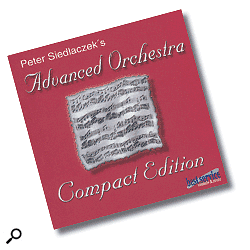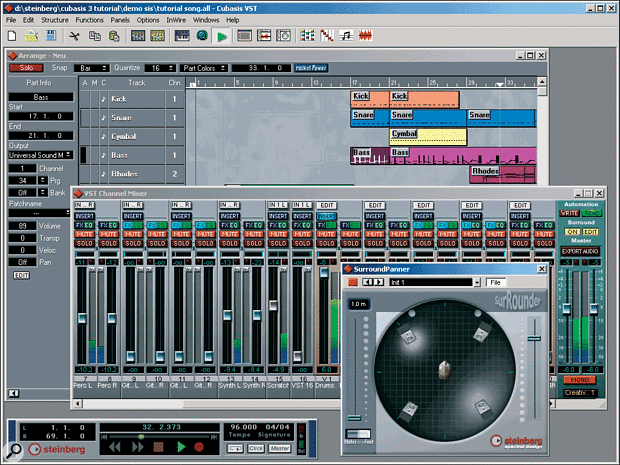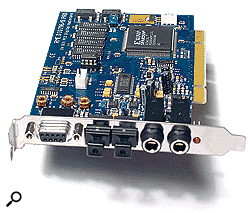Q. Can I use my drum pads to trigger drum machine
sounds?
 MIDI pads such as the Roland SPD86 are ideal for capturing a live, stick-led drum performance.I currently own some Roland SPD6 MIDI drum pads, and I want to be able to record from them into some kind of drum machine, so that I can use the rhythms in a live situation later (I play guitar and sing in a trio with a guitarist and synth player.) My local music shops tell me that things like the Zoom and Boss drum machines on the market today will not do this, as they say you cannot connect via MIDI and record the external MIDI information into them. Is there any other product that might be worth looking at?
MIDI pads such as the Roland SPD86 are ideal for capturing a live, stick-led drum performance.I currently own some Roland SPD6 MIDI drum pads, and I want to be able to record from them into some kind of drum machine, so that I can use the rhythms in a live situation later (I play guitar and sing in a trio with a guitarist and synth player.) My local music shops tell me that things like the Zoom and Boss drum machines on the market today will not do this, as they say you cannot connect via MIDI and record the external MIDI information into them. Is there any other product that might be worth looking at?
Mark May
Reviews Editor Mike Senior replies: If you're happy with the kinds of sounds you can get from the average drum machine, you could consider getting one of Yamaha's little QY-series hardware sequencers — the most recent we reviewed was the QY100. These have MIDI recording (called MIDI sequencing) facilities built into them, along with a MIDI sound module to provide the sounds. You could plug your SPD6 pads into the MIDI input on one of those machines and record your performance in real time. Then you could re-record sections or edit note-by-note, if you wished. The QY100 is inexpensive, and very portable, too, so it would be good for gigs. You can check out the specs in our review (SOS February 2002) and by downloading the manual from the Yamaha web site's library. Check out the rest of the QY range, too, because each one offers a different balance of facilities.
If you're after more realistic sounds, I'd suggest something like an Akai MPC2000, which also contains a MIDI sequencer. However, instead of a generic MIDI sound module, you get a drum sampler, which allows you to use the most suitable sounds for your music. You could also look at the Yamaha RS7000 for this, and perhaps the Korg Triton or Trinity keyboard workstations with the sampling option (though these would be rather more expensive). Each provides these kinds of sampling and sequencing facilities in a slightly different format.
Q. Are red indicators in audio software significant?
What is the best level, or what should be the highest indicator point in mixing, using computer software such as Nuendo or Samplitude? At times the mix will sound low when the LEDs are hitting red. Am I using my compressors wrongly? Also, how can you tell that your song is really going to have the desired punch in a club setting? This has given me headaches with clients complaining that their songs are not 'punching' hard enough. My overall compressor is the Timeworks mastering compressor.
Chris Musyoka
Features Editor Sam Inglis replies: Red lights in any digital system, including computer software, indicate digital overloads and should be avoided. When a signal exceeds the maximum level available in a digital system, the audible result is digital distortion, which is not at all like the 'warm' sound of an overloaded analogue tape recorder or mixer channel, and is usually very unpleasant.
Having said that, there are sounds (such as snare drums) where brief overloads are not very noticeable, and the mixing engines in many software packages seem designed to alleviate some of the audible consequences of overloading. As usual, if it sounds good, don't worry about how it looks! It should, however, be possible to get a punchy mix without continually overloading channel busses — if you find all your channels in Nuendo are showing red lights, pull the faders down on all the channels and boost the Master channel instead.
The usual way of achieving 'punch' is to process the mix buss with a stereo compressor and/or limiter: multi-band models generally achieve more transparent results than full-band ones. However, if your mix isn't punchy to start with, no amount of mix buss processing is really going to help that much, so you probably need to address some more fundamental issues. Is your monitoring system properly set up? Do your sounds sit well together in the mix? For instance, do your bass and kick drum sounds get muddled because they occupy the same frequency range, or do they complement each other?
Reviews Editor Mike Senior adds: The best advice I can give is to ask your clients to bring in tracks which they consider to have the required amount of 'punch' and then to adjust your compressor and EQ settings to match these reference tracks. Set up your monitoring system so that you can quickly switch between your mix and the output of your mix buss — it's vital that you A/B very quickly, as this stops your ear compensating for any deficiencies in your mix.
If you need advice on compression and EQ, I'd suggest looking up the Advanced Compression workshops (in the December 2000 and January 2001 issues of SOS) and the two EQ workshops in July and August 2001. You might also want to look up the Advanced Gating workshops (April 2000 and May 2001), and the multi-band compression workshop (August 2002). This is only the tip of the iceberg, though, given that there are eight years or so of back issues available free to read on-line, many of them workshops. Mix processing is an extremely difficult thing to do effectively, so don't be afraid to mix things several times in order to experiment.
Q. What is 'zero level'?
Could you give me a definition of 'zero level', or explain what it is? I am a University student in my first year, studying sound recording, and I can't seem to find a definition for this anywhere! Any reply will be greatly appreciated.
SOS Forum post
Technical Editor Hugh Robjohns replies: Virtually every book published in the last 20 years that discusses recording techniques explains zero level in some depth (I have a bookcase full of them here), so the best thing to do would be to investigate your college library and do the homework for yourself. However, because there may be some confusion out there, I'll try and provide a simple explanation.
Audio signals are measured in decibels (dB), as you no doubt know, and zero level is slang shorthand for the 0dB point — ie. where the reference and measured signal have the same value. However, that reference changes depending on what you are talking about.
Q. Can you advise me on vocal recording and
microphones?
I currently have a small home studio and am making a a few different styles of music but mainly house and trance. I've used samples for remixing tracks but never done any actual vocal recording myself. Not so long ago I was asked by the lead singer of a group if I would help them do some recording. I really am interested in doing it, but the problem I'm hitting is acoustic treatment for the recording booth. It's so expensive, and reading the Studio SOS article in the October issue this year I see Paul White using a duvet for dampening down room reflections. Would it be good enough to hang duvets on the walls of the vocal booth ? Also, I'm not sure what mic I will be buying, as I don't know a great deal about them. I'll be on a budget of about £4-500. The mic will be running straight into the mixer itself, which hopefully will be the Mackie 32-channel. I have been told that it would be fine to run the mic straight into the mixer, as the Mackie's quality is very good.
Craig Young
Your main choice will be whether to go for a solid-state or a valve model. The solid-state ones will give good results on a variety of different sounds, but the enhancement provided by a valve model may be more suitable for your vocal-only applications, if you want that kind of sound. If you're after a solid-state mic, our Editor Paul White very much likes the Rode NT mics — the NT1 is currently excellent value. There's also a very nice Rode valve mic, the NTK, which is within your budget.
Another one to have a look at is the AKG SolidTube, which I've heard models its sound on my personal favourite vocal mic, the AKG C12. Having a quick look through the Turnkey ad in this month's issue, there's also a good deal on the AKG C414, a classic solid-state mic, which brings it within your price range. There's also the Neumann TLM103, which is another lovely mic from a pedigree manufacturer, for around £470. In short, you're spoilt for choice, even without considering the flood of super-cheap Chinese-built clones from Joemeek, Red5 Audio, Studio Projects, Canford, Samson, MXL, and a growing number of others. The good news is that you shouldn't go wrong with any of the mics I've named above. Furthermore, any money you spend on a good mic will certainly not be wasted, so don't necessarily head for the cheapest option.
As for plugging the mic directly into your mixer, if you're getting one of the Mackie 'VLZPro' models, the mic preamps should easily do your choice of mic justice.
Q. Why have my faders stopped working?
I'm using a Roland VS880 digital multitrack, and one of my songs has developed a weird bug. The faders aren't working — they're just dead. Looking into the track parameters, I see that the channel mix levels are stuck on a fixed value with an asterisk after it (eg. 'CH MIX LEVEL=102*'), and using the wheel to vary the value is now the only way I can think of to alter it. Any ideas?
Alan Pittaway
Reviews Editor Mike Senior replies: I have a couple of ideas as to the root of the problem. That asterisk after the fader value means that the position of the physical fader is not representative of the actual internal level parameter. This situation can easily arise in normal use, because of using the same set of faders to adjust several sets of level parameters, and also because the automation can move the level parameter but not the physical fader.
If a mismatch between the level parameter and the physical fader occurs, you can normally set the level parameter to the physical fader position simply by moving the fader. However, if the Fader Match mode (set in the System menu's System Prm sub-menu, I think) is set to 'Null', you have to move the physical fader through the current level parameter value before the level parameter will follow the physical fader again. If you want it to work as it did before, simply switch Fader Match to 'Jump'.
If this does't sort things out, it's probably because you've got the machine's local control switched off. Head to the System menu's MIDI Prm sub-menu and switch the Cntrl Local switch to 'On'. What is the MIDI Local Control switch there for, I hear you wonder? It's for using the VS with a sequencer, so that you don't get a situation where the VS faders and the sequencer are both sending control signals to the VS's internal digital mixer.
Q. Does normalising have any adverse effects on
audio?
I have a question to which I haven't really been able to find an answer. Most of the time, I tend to record audio to my Pro Tools LE system at somewhat under digital full scale, so that I'm 100 percent certain of not getting any distortion. Recordings are then normalised, maximising the peaks and making the audio as 'loud' as possible while maintaining dynamics, before I start mixing. What I'd like to know is whether the normalisation process actually changes or degrades the audio in any way, beyond adding bits to increase level.
Alex Elliott
Technical Editor Hugh Robjohns replies: The normalising process searches the audio file for the highest recorded peak, and then applies gain to the entire file to raise that highest peak to 0dBFS, thus raising the level of the entire file. A lot of people work this way, and it is a useful technique, since you can allow sufficient headroom during recording to avoid transient overloads, yet peak levels can subsequently be maintained at a similar level to commercial products.
Obviously, the amount of gain added to normalise the signal will also raise the noise floor by the same amount, but with the prevalence of 24-bit converters these days, the noise floor is almost certainly going to be dominated by your own recording environment rather than the resolution of the recording system, so you are not losing anything in this process. The original dynamic range will be maintained.
The only other possible cause for concern is the issue of 0dBFS peaks. While working on the signal within the DAW environment (assuming a floating-point DSP system) this causes no problems whatever. However, some thought and care needs to be given to using normalised signals for making CDs. Although it is common practice to peak signals to 0dBFS during CD mastering, some mastering engineers are now making -0.5dBFS (or even lower) their maximum level. The reason is to avoid the danger of overloading the D-A converter in the replay system, since reconstructing a signal which has several 0dBFS peaks in close succession can create an analogue waveform which has a greater amplitude than its source samples. This can overload the D-A converter or the analogue electronics, which is clearly not a good thing.
Q. Can I obtain better orchestral sounds on a
budget?
I have a very humble home studio comprising a PC running Windows 98, a Creative Labs Soundblaster Live soundcard with MIDI interface, a basic 76-key controller and Steinberg Cubasis VST software. I write classical compositions, which means all of the above gear has been an investment, enabling me to score at 10 times the speed of transcription by hand.
The problem I have is that the SoundFonts supplied with the Creative package are OK but not accurate enough and produce a bad simulation of an orchestra. This defeats the purpose for me. Can I get hold of better banks of SoundFonts, say on CD somewhere? If this is not possible, is my only option to purchase a sound module such as the Emu Proteus?
Allan Wiseman
 If you really want orchestral realism. there's nothing to beat a sampler (perhaps a soft sampler like Steinberg's HALion) and some decent orchestral sample libraries.
If you really want orchestral realism. there's nothing to beat a sampler (perhaps a soft sampler like Steinberg's HALion) and some decent orchestral sample libraries.
If your PC is a recent model with a reasonably fast CPU and plenty of memory, however, my suggestion would be that you look for a software sampler or synthesizer instead. (It would be worth checking that your version of Cubasis supports VST Instruments, as this would be the most convenient format for you.) If you want the ultimate in realism, you would choose a software sampler such as HALion and a selection of orchestral libraries on CD. However, this will be expensive and time-consuming to set up, and if you want an all-in-one, easy-to-use solution, the most obvious choice would be Edirol's Orchestral Instrument. It won't give you the same realism that you'd get from a nine-CD £1000 library of string samples, but I think you would notice a substantial improvement over the Creative SoundFonts.
Published January 2003
Published January 2003







